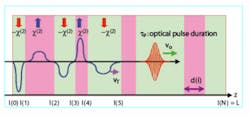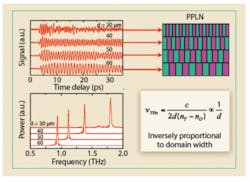Poled lithium niobate crystals enable multicycle THz pulse generation
The terahertz frequency range (approximately 0.1 to 10 THz) lies between the microwave and infrared regimes of the electromagnetic (EM) spectrum, but terahertz (THz) science and technology lags considerably behind the microwave and infrared regimes because of significant limitations in coherent THz generation and detection. The highest frequency achieved by electronic technologies does not exceed a few hundred gigahertz. Infrared optical devices typically generate and detect EM waves at tens of THz at best, although a few far-IR gas lasers and very recently quantum-cascade lasers have provided coherent continuous-wave (CW) radiation at select frequencies in the THz range.
Recently, however, THz technology has become an extremely active field of research, and the development of new THz sources and detectors has been filling the “THz gap.” These new technologies offer the potential to integrate electronic and optical devices, which is expected to enable ultra-high-speed computation and communications beyond signal switching rates of 100 Gigabits/s. Also, several research groups are exploring the potential of THz time-domain imaging for diverse applications such as package inspection and medical diagnosis. In addition, time-domain molecular spectroscopy of rotational and vibrational dynamics is one of the promising applications of THz technology for identification and characterization of molecules.
One approach to THz generation is via nonlinear optics with ultrafast lasers: because the low-THz frequency range corresponds to the inverse of femtosecond pulse duration, femtosecond lasers have been widely used to generate ultra-broadband, single-cycle THz waves. On the other extreme, free-electron lasers and quantum-cascade lasers have been used as CW THz sources. Many applications, however, will require arbitrary THz waveform generation, as opposed to single-cycle or CW THz sources, in a fashion similar to the user-specified waveforms used in optical pulse shaping or the RF waveforms used in nuclear magnetic resonance (NMR).
The first step toward flexible THz waveform generators has been achieved recently—it has been demonstrated that complex multicycle THz pulses can be generated via optical rectification in poled lithium niobate (PLN) crystals using femtosecond optical pulses.
Pre-engineered domain structure
When a femtosecond optical pulse propagates through a PLN crystal with a pre-engineered domain structure, such that the second-order nonlinear susceptibility (γχ(2)) of the crystal reverses sign between neighboring domains, a THz nonlinear polarization is generated via optical rectification (see Fig. 1). Because of the mismatch between the optical group velocity and the THz phase velocity (for example, the optical and THz indices of refraction of LiNbO3 are nO = 2.3 and nT = 5.2, respectively), the optical pulse will lead the THz pulse by the optical pulse duration τp after a walk-off length
lw = cτp/(nT- nO).
If the domain length (d(i)) of the poled nonlinear crystal is comparable to the walk-off length, each domain in the crystal contributes a half cycle to the radiated THz field. Because the length of the half-cycle pulse is proportional to the corresponding domain length, the resulting THz pulse directly corresponds to the crystal domain structure.When the domain structure is periodic—that is, the domain lengths are identical (d(i) = d)—narrow-band multicycle THz pulses can be generated. For instance, in a periodically poled lithium niobate (PPLN) crystal with domain widths of 30, 40, 50, and 60 µm at T = 115 K, the optical pump spectrum is centered at 800 nm and the pulse duration is 150 fs (see Fig. 2).1 The generated THz waves are focused by a pair of off-axis paraboloidal mirrors into a 1-mm (110)-cut ZnTe crystal. The THz waveform is measured by free-space electro-optic sampling.2 The sample is a z-cut PPLN crystal that is laterally chirped (multiple domain structures of slightly different domain width were fabricated side by side at a regular distance from one to another). The domain width varies from 30 to 60 µm with 5-µm step size. The relative bandwidth ∆ν/ν of the THz field is given simply by 2/N in the absence of absorption and domain-width fluctuations, where N is the number of domains in the PPLN.
The frequency of the THz wave is determined as νTHz = c/2d(nT - nO) where c is the light velocity, d is the domain-width, and nT(nO) is the group refractive index at THz (optical) frequency. Tuning of the THz frequency is accomplished simply by scanning the sample laterally to the beam propagation direction, and the THz wave from the shorter domains is generated with higher frequency as expected. Continuous THz frequency tuning also has been demonstrated using fanned-out PPLN crystals in which the domain width varies continuously across the lateral direction.
Characterizing domain structure
It is interesting to note that, because the THz waveform is essentially a direct manifestation of the crystal domain structure, the multicycle THz-generation method provides a novel approach to characterizing the domain structure of poled materials. Because the domain structure of the materials affects the physical properties of the crystals in many aspects, it is important to understand the patterns of the domain structure.One direct method is the observation of differentially etched domains using surface-probing tools, although this results in the inevitable destruction of the sample. On the other hand, probing the inner crystal domain structure by analyzing the THz waveforms generated by optical rectification in ferro-electric crystals should be a nondestructive technique. In an optical image of the electrode pattern of a PPLN crystal, magnified to exaggerate the domain lengths, the optic axis of the sample is normal to the surface (see Fig. 3, left).3 The sample is wedged, and the domain structure of the sample is supposed to match with the electrode pattern, but in reality each domain suffers width fluctuations due to the strong coercive electric fields and field leakage out of the electrodes.
To probe the entire domain structure of the PPLN, the PPLN sample was scanned laterally with respect to the fixed excitation beam. The optical excitation beam is vertically positioned in the middle of the sample. The THz waveform image of the PPLN domain structure indicates that the domain structure is fairly periodic, which is consistent with the electrode pattern (see Fig. 3, right).3 Fifteen data points are taken along the x-axis; values between the data points are interpolated. In the narrower region of the crystal, the effective optical beam path is shorter, thus the THz waves arrive earlier than in the wider region. The slanted domain interfaces to the sample surfaces are also well reproduced in the THz waveform image.
Arbitrary waveforms
Arbitrary THz waveforms can be obtained using nonperiodic PLN crystals. Experimental results and numerical simulations for three different types of PLN structures demonstrate the feasibility and versatility of the THz pulse shaping scheme (see Fig. 4).4First, the zero-area double pulse consisting of two pulses with a π phase shift is generated from a domain structure in which a single domain (100 µm) is placed between two sets of multiple domains (50 µm). The corresponding spectrum clearly shows the signature of the interference fringes of two coherent pulses (see Fig. 4, top). The phase-locked double pulses can be applied to coherent control experiments ranging from chemical reactions to semiconductor carrier dynamics.
Second, the domain structure for a chirped THz waveform pulse includes multiple domains ranging from 20 to 90 µm with 1-µm gradual increment (see Fig. 4, center). Chirped pulses in the optical regime have been used in the control of atomic-wave packets via adiabatic transfer. Similarly, chirped THz pulses are applicable to adiabatic transfer between excitonic wave packets in semiconductor nanostructures or between rotational and vibrational modes of molecules.
Third, narrow and broad half-cycle pulses in the waveform from a structure of alternating domain length (30 and 60 µm) appear alternately, and a second-harmonic signal appears because of the asymmetric domain structure (see Fig. 4, bottom). It can be used to excite two spectrally separated molecular transitions simultaneously. The flexibility of this pulse shaping technique also has been shown in a recent theoretical work demonstrating the generation of coherent narrow-band THz radiation with multifrequency modes in an optical super lattice of ferro-electric domains arranged as a Fibonacci sequence.5
In general, the results clearly show that shaped THz pulses can be generated in PLN structures. Most of the quantitative discrepancy between experiment and simulation comes from the temporal decay of the THz pulses in the experiments because of the THz absorption in LiNbO3 by optical phonons. Cooling down the samples below 100 K suppresses the THz absorption significantly.1
Commercial availability
Because PPLN crystals based on quasi-phase-matching techniques have been in demand for diverse uses such as optical frequency conversion and high-speed switching devices for light modulation, several companies now fabricate PPLN crystals based on customers’ specifications and requirements.
HC Photonics (Hsinchu, Taiwan), INO (Sainte-Foy, Quebec City, Canada), and Isowave (Dover, NJ) are among those companies capable of customized PLN fabrication. It is also worthwhile to refer to other crystals with different bandwidth, emission intensity, and damage threshold. Ferro-electric crystals such as potassium niobate (KNbO3), lithium tantalate (LiTaO3), potassium titanyl phosphate (KTiOPO4 or KTP), and rubidium titanyl arsenate (RbTiOAsO4 or RTA) can be used to generate multicycle THz pulses.
Quasi-phase-matched crystals of KNbO3, KTP, and LiTaO3 containing periodically poled structures already have been fabricated. Periodically poled KTP crystals are commercially available from Cobolt (Stockholm, Sweden).
Besides ferro-electric crystals, super-lattice structures of III-V semiconductors and organic crystals such as diethyl amino sulfur trifluoride (DAST) might also be used in multicycle THz pulse generation.
Generation of arbitrary THz waveforms has great potential for applications in THz imaging systems, ultrafast optical signal processing, ultra-high-speed computing, quantum information science, nanotechnology, and chemical-reaction dynamics, among other areas. Terahertz time-domain spectroscopy permits precise measurements not only of the amplitude but also of the phase of THz waves. The phase sensitivity is vital to many applications such as high-contrast THz imaging and quantum control of semiconductor nanostructures.
REFERENCES
1. Y. -S. Lee et al., Appl. Phys. Lett.78, 3583 (2001).
2. Q. Wu and X.-C. Zhang, Appl. Phys. Lett. 68, 1604 (1996).
3. Y. -S. Lee et. al., Appl. Phys. Lett. 77, 2488 (2000).
4. Y. -S. Lee et. al., Appl. Phys. Lett.82, 170 (2003).
5. Y. Qin et. al., Appl. Phys. Lett.83, 1071 (2003).



